红外波段的发射率、透过率和反射率的关系
- 格式:docx
- 大小:16.94 KB
- 文档页数:3
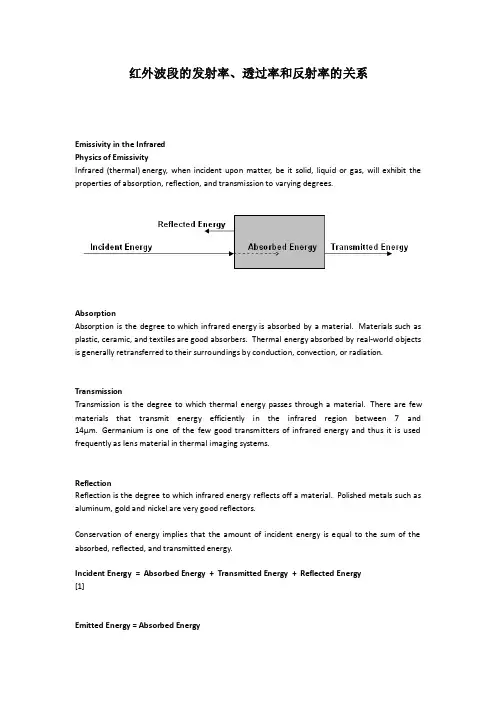
红外波段的发射率、透过率和反射率的关系Emissivity in the InfraredPhysics of EmissivityInfrared (thermal) energy, when incident upon matter, be it solid, liquid or gas, will exhibit the properties of absorption, reflection, and transmission to varying degrees.AbsorptionAbsorption is the degree to which infrared energy is absorbed by a material. Materials such as plastic, ceramic, and textiles are good absorbers. Thermal energy absorbed by real-world objects is generally retransferred to their surroundings by conduction, convection, or radiation.TransmissionTransmission is the degree to which thermal energy passes through a material. There are few materials that transmit energy efficiently in the infrared region between 7 and 14µm. Germanium is one of the few good transmitters of infrared energy and thus it is used frequently as lens material in thermal imaging systems.ReflectionReflection is the degree to which infrared energy reflects off a material. Polished metals such as aluminum, gold and nickel are very good reflectors.Conservation of energy implies that the amount of incident energy is equal to the sum of the absorbed, reflected, and transmitted energy.Incident Energy = Absorbed Energy + Transmitted Energy + Reflected Energy[1]Emitted Energy = Absorbed EnergyConsider equation 1 for an object in a vacuum at a constant temperature. Because it is in a vacuum, there are no other sources of energy input to the object or output from the object. The absorbed energy by the object increases its thermal energy - the transmitted and reflected energy does not. In order for the temperature of the object to remain constant, the object must radiate the same amount of energy as it absorbs.Emitted Energy = Absorbed Energy[2]Therefore, objects that are good absorbers are good emitters and objects that are poor absorbers are poor emitters. Applying equation 2, Equation 1 can be restated as follows:Incident Energy = Emitted Energy + Transmitted Energy + Reflected Energy[3]Setting the incident energy equal to 100%, the equation 3 becomes:100% = %Emitted Energy + %Transmitted Energy + %Reflected Energy[4]Because emissivity equals the efficiency with which a material radiates energy, equation 4 can be restated as follows:100% = Emissivity + %Transmitted Energy + %Reflected Energy[5]Applying similar terms to %Transmitted Energy and %Reflected Energy,100% = Emissivity + Transmissivity(透过率)+ Reflectivity[6]According to equation 6, there is a balance between emissivity, transmissivity, and reflectivity. Increasing the value of one of these parameters requires a decrease in the sum of the other two parameters. If the emissivity of an object increases, the sum of its transmissivity and reflectivity must decrease. Likewise, if the reflectivity of an object increases, the sum of its emissivity and trasmissivity must decrease.Most solid objects exhibit very low transmission of infrared energy - the majority of incident energy is either absorbed or reflected. By setting transmissivity equal to zero, equation 6 can be restated as follows:100% = Emissivity + Reflectivity[7]For objects that do not transmit energy, there is a simple balance between emissivity and reflectivity. If emissivity increases, reflectivity must decrease. If reflectivity increases, emissivity must decrease. For example, a plastic material with emissivity = 0.92 has reflectivity = 0.08. A polished aluminum surface with emissivity = 0.12 has reflectivity = 0.88.The emissive and reflective behavior of most materials is similar in the visible and infrared regions of the electromagnetic spectrum. Polished metals, for example, have low emissivity and high reflectivity in both the visible and infrared. It is important to understand, however, that some materials that are good absorbers, transmitters, or reflectors in the visible, may exhibit completely different characteristics in the infrared.。
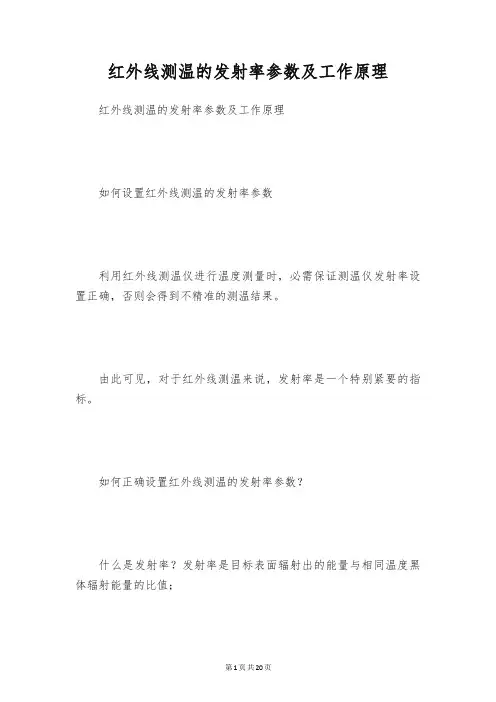
红外线测温的发射率参数及工作原理红外线测温的发射率参数及工作原理如何设置红外线测温的发射率参数利用红外线测温仪进行温度测量时,必需保证测温仪发射率设置正确,否则会得到不精准的测温结果。
由此可见,对于红外线测温来说,发射率是一个特别紧要的指标。
如何正确设置红外线测温的发射率参数?什么是发射率?发射率是目标表面辐射出的能量与相同温度黑体辐射能量的比值;它是由物体本身的材质决议的,例如,塑料的发射率为0.95,冰的发射率为0.98,玄武岩的发射率为0.7等等。
既然如此,为了获得正确的测量温结果,我们在用红外线测温仪测量温度前;应依据被测目标的材质,来设置正确的发射率参数,如何设置红外线测温仪的发射率参数呢?紧要有三种方法。
1、涂色法。
此种方法紧要是将被目标表面涂成黑色,并将测温仪发射率设置为黑色涂料(或黑色胶布)的发射率0.97(0.93),然后用红外线测温仪测量黑色部位的温度T1;再用红外线测温仪测量与黑色部位靠近部位的表面温度T2,调整红外线测温仪的发射率值,使T2*接近于T1,此时得到的发射率值即为被测目标的发射率。
2、比对法。
找一接触式测温探头,测量被测目标表面的温度,待温度达到稳定后,调整红外线测温仪的发射率;使得红外线测温仪测得的温度值与接触式测温探头测得的温度显示一致,此时的发射率即为被测目标的发射率。
3、查表法。
依据操作手册或相关文档供应的发射率表,依据被测目标的材质,查找相对应的发射率值进行设置。
大家可以依据实际情况,来对红外线测温仪的发射率进行设置,以获得精准的测量结果。
红外测温仪的工作原理红外测温仪技术的进展,其具有使用便利、测量精度高且测量距离远等优点为用户供应了各种功能及用途的仪器。
红外测温仪从原理上来说有便携式测温仪和固定式测温仪两种,因此,在选择合适的红外测温仪用于不同的测量点时;以下的特征将是紧要的:1、瞄准器瞄准器有此作用,测温仪所指的测量块或测量点可以看到,大面积的被测物可以常常不要瞄准器。
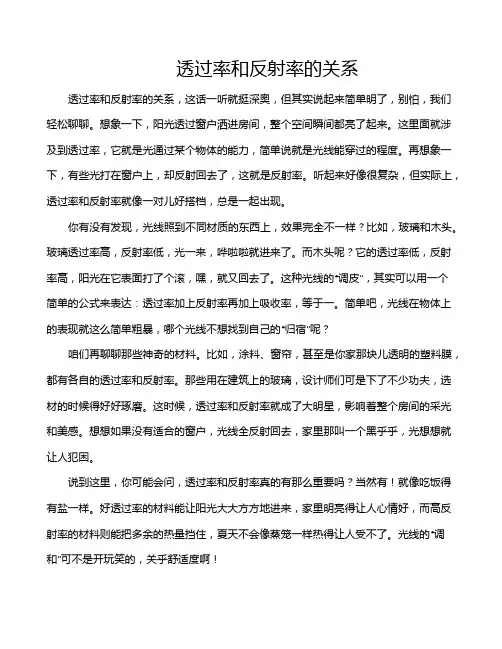
透过率和反射率的关系透过率和反射率的关系,这话一听就挺深奥,但其实说起来简单明了,别怕,我们轻松聊聊。
想象一下,阳光透过窗户洒进房间,整个空间瞬间都亮了起来。
这里面就涉及到透过率,它就是光通过某个物体的能力,简单说就是光线能穿过的程度。
再想象一下,有些光打在窗户上,却反射回去了,这就是反射率。
听起来好像很复杂,但实际上,透过率和反射率就像一对儿好搭档,总是一起出现。
你有没有发现,光线照到不同材质的东西上,效果完全不一样?比如,玻璃和木头。
玻璃透过率高,反射率低,光一来,哗啦啦就进来了。
而木头呢?它的透过率低,反射率高,阳光在它表面打了个滚,嘿,就又回去了。
这种光线的“调皮”,其实可以用一个简单的公式来表达:透过率加上反射率再加上吸收率,等于一。
简单吧,光线在物体上的表现就这么简单粗暴,哪个光线不想找到自己的“归宿”呢?咱们再聊聊那些神奇的材料。
比如,涂料、窗帘,甚至是你家那块儿透明的塑料膜,都有各自的透过率和反射率。
那些用在建筑上的玻璃,设计师们可是下了不少功夫,选材的时候得好好琢磨。
这时候,透过率和反射率就成了大明星,影响着整个房间的采光和美感。
想想如果没有适合的窗户,光线全反射回去,家里那叫一个黑乎乎,光想想就让人犯困。
说到这里,你可能会问,透过率和反射率真的有那么重要吗?当然有!就像吃饭得有盐一样。
好透过率的材料能让阳光大大方方地进来,家里明亮得让人心情好,而高反射率的材料则能把多余的热量挡住,夏天不会像蒸笼一样热得让人受不了。
光线的“调和”可不是开玩笑的,关乎舒适度啊!再来一段有趣的:想象一下,你在海边,阳光照在水面上。
那反射率简直高得惊人,水面像一面镜子,光线一来就反弹回去。
于是你发现自己老是眯着眼,不是因为你帅,而是光线真是太刺眼。
那种感觉就像被光线戏弄了一样,哎,这反射率真是个顽皮的家伙。
可见,透过率和反射率不仅仅是科学问题,还是生活中的小乐趣。
随着科技的进步,透过率和反射率的应用越来越广泛。

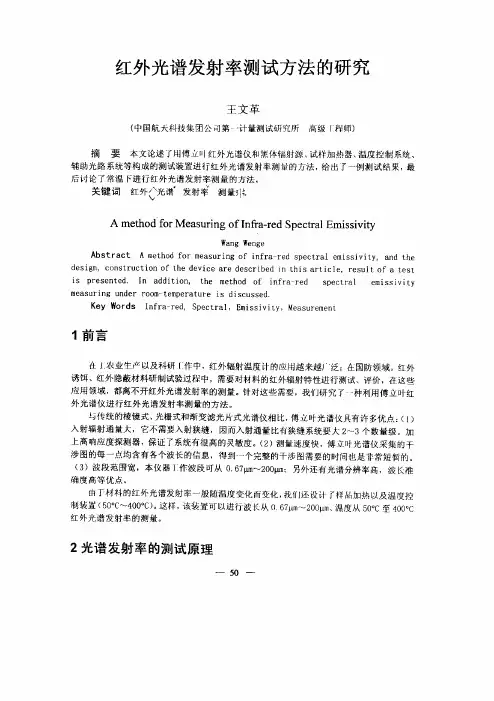
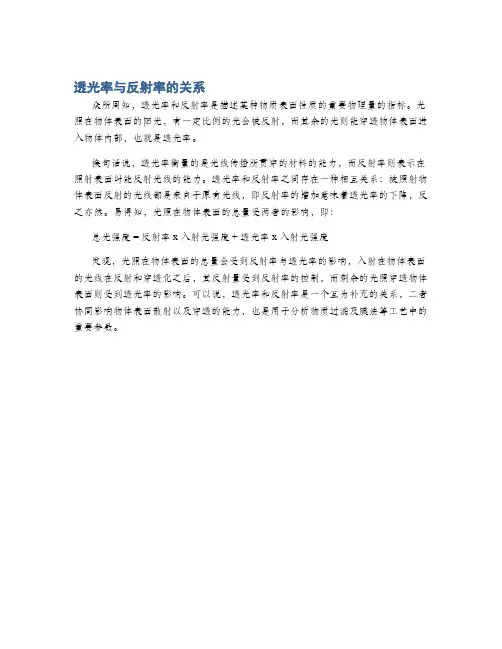
透光率与反射率的关系
众所周知,透光率和反射率是描述某种物质表面性质的重要物理量的指标。
光照在物体表面的阳光,有一定比例的光会被反射,而其余的光则能穿透物体表面进入物体内部,也就是透光率。
换句话说,透光率衡量的是光线传播所贯穿的材料的能力,而反射率则表示在照射表面时能反射光线的能力。
透光率和反射率之间存在一种相互关系:被照射物体表面反射的光线都是来自于原有光线,即反射率的增加意味着透光率的下降,反之亦然。
易得知,光照在物体表面的总量受两者的影响,即:
总光强度 = 反射率 x 入射光强度 + 透光率 x 入射光强度
发现,光照在物体表面的总量会受到反射率与透光率的影响,入射在物体表面的光线在反射和穿透化之后,其反射量受到反射率的控制,而剩余的光照穿透物体表面则受到透光率的影响。
可以说,透光率和反射率是一个互为补充的关系,二者协同影响物体表面散射以及穿透的能力,也是用于分析物质过滤及膜法等工艺中的重要参数。
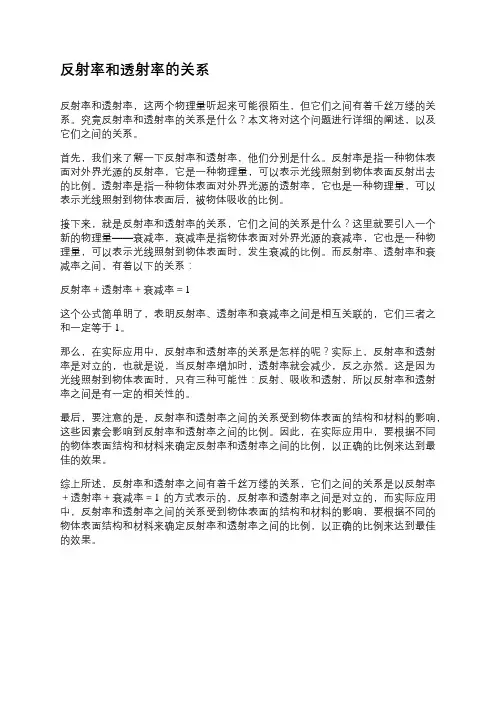
反射率和透射率的关系反射率和透射率,这两个物理量听起来可能很陌生,但它们之间有着千丝万缕的关系。
究竟反射率和透射率的关系是什么?本文将对这个问题进行详细的阐述,以及它们之间的关系。
首先,我们来了解一下反射率和透射率,他们分别是什么。
反射率是指一种物体表面对外界光源的反射率,它是一种物理量,可以表示光线照射到物体表面反射出去的比例。
透射率是指一种物体表面对外界光源的透射率,它也是一种物理量,可以表示光线照射到物体表面后,被物体吸收的比例。
接下来,就是反射率和透射率的关系,它们之间的关系是什么?这里就要引入一个新的物理量——衰减率,衰减率是指物体表面对外界光源的衰减率,它也是一种物理量,可以表示光线照射到物体表面时,发生衰减的比例。
而反射率、透射率和衰减率之间,有着以下的关系:反射率+透射率+衰减率=1这个公式简单明了,表明反射率、透射率和衰减率之间是相互关联的,它们三者之和一定等于1。
那么,在实际应用中,反射率和透射率的关系是怎样的呢?实际上,反射率和透射率是对立的,也就是说,当反射率增加时,透射率就会减少,反之亦然。
这是因为光线照射到物体表面时,只有三种可能性:反射、吸收和透射,所以反射率和透射率之间是有一定的相关性的。
最后,要注意的是,反射率和透射率之间的关系受到物体表面的结构和材料的影响,这些因素会影响到反射率和透射率之间的比例。
因此,在实际应用中,要根据不同的物体表面结构和材料来确定反射率和透射率之间的比例,以正确的比例来达到最佳的效果。
综上所述,反射率和透射率之间有着千丝万缕的关系,它们之间的关系是以反射率+透射率+衰减率=1的方式表示的,反射率和透射率之间是对立的,而实际应用中,反射率和透射率之间的关系受到物体表面的结构和材料的影响,要根据不同的物体表面结构和材料来确定反射率和透射率之间的比例,以正确的比例来达到最佳的效果。
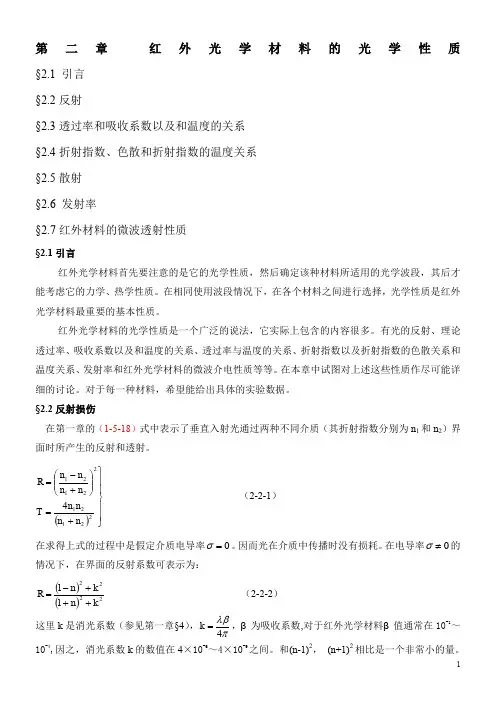
第二章 红外光学材料的光学性质§2.1 引言 §2.2反射§2.3透过率和吸收系数以及和温度的关系 §2.4折射指数、色散和折射指数的温度关系 §2.5散射 §2.6 发射率§2.7红外材料的微波透射性质§2.1引言红外光学材料首先要注意的是它的光学性质,然后确定该种材料所适用的光学波段,其后才能考虑它的力学、热学性质。
在相同使用波段情况下,在各个材料之间进行选择,光学性质是红外光学材料最重要的基本性质。
红外光学材料的光学性质是一个广泛的说法,它实际上包含的内容很多。
有光的反射、理论透过率、吸收系数以及和温度的关系、透过率与温度的关系、折射指数以及折射指数的色散关系和温度关系、发射率和红外光学材料的微波介电性质等等。
在本章中试图对上述这些性质作尽可能详细的讨论。
对于每一种材料,希望能给出具体的实验数据。
§2.2反射损伤在第一章的(1-5-18)式中表示了垂直入射光通过两种不同介质(其折射指数分别为n 1和n 2)界面时所产生的反射和透射。
()⎪⎪⎭⎪⎪⎬⎫+=⎪⎪⎭⎫ ⎝⎛+-=22121221214n n n n T n n n n R (2-2-1) 在求得上式的过程中是假定介质电导率0=σ。
因而光在介质中传播时没有损耗。
在电导率0≠σ的情况下,在界面的反射系数可表示为:()()222211kn k n R +++-= (2-2-2) 这里k 是消光系数(参见第一章§4),πλβ4=k ,β为吸收系数,对于红外光学材料β值通常在10-1~10-4,因之,消光系数k 的数值在4×10-6~4×10-9之间。
和(n-1)2, (n+1)2相比是一个非常小的量。
因而,在反射率的计算中完全可以忽略。
于是,单面反射率通常可以表示为:()()2211n n R +-= (2-2-3)这里R 是垂直入射时的反射率。
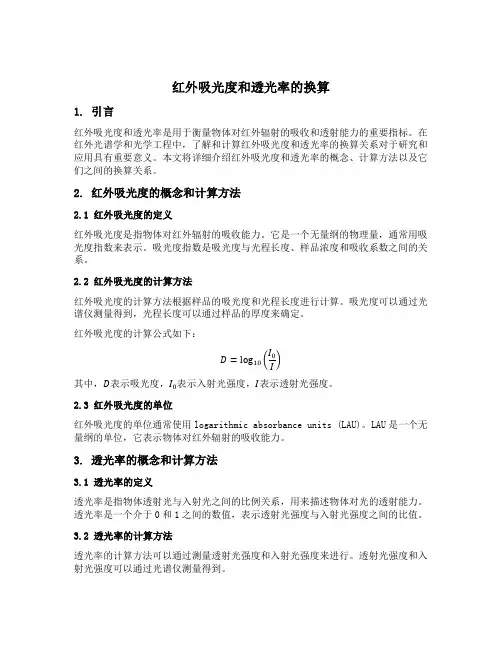
红外吸光度和透光率的换算1. 引言红外吸光度和透光率是用于衡量物体对红外辐射的吸收和透射能力的重要指标。
在红外光谱学和光学工程中,了解和计算红外吸光度和透光率的换算关系对于研究和应用具有重要意义。
本文将详细介绍红外吸光度和透光率的概念、计算方法以及它们之间的换算关系。
2. 红外吸光度的概念和计算方法2.1 红外吸光度的定义红外吸光度是指物体对红外辐射的吸收能力。
它是一个无量纲的物理量,通常用吸光度指数来表示。
吸光度指数是吸光度与光程长度、样品浓度和吸收系数之间的关系。
2.2 红外吸光度的计算方法红外吸光度的计算方法根据样品的吸光度和光程长度进行计算。
吸光度可以通过光谱仪测量得到,光程长度可以通过样品的厚度来确定。
红外吸光度的计算公式如下:D=log10(I0 I )其中,D表示吸光度,I0表示入射光强度,I表示透射光强度。
2.3 红外吸光度的单位红外吸光度的单位通常使用logarithmic absorbance units (LAU)。
LAU是一个无量纲的单位,它表示物体对红外辐射的吸收能力。
3. 透光率的概念和计算方法3.1 透光率的定义透光率是指物体透射光与入射光之间的比例关系,用来描述物体对光的透射能力。
透光率是一个介于0和1之间的数值,表示透射光强度与入射光强度之间的比值。
3.2 透光率的计算方法透光率的计算方法可以通过测量透射光强度和入射光强度来进行。
透射光强度和入射光强度可以通过光谱仪测量得到。
透光率的计算公式如下:T=I I0其中,T表示透光率,I0表示入射光强度,I表示透射光强度。
3.3 透光率的单位透光率是一个无量纲的物理量,它表示透射光强度与入射光强度之间的比例关系。
4. 红外吸光度和透光率的换算关系红外吸光度和透光率之间存在着一种换算关系。
通过红外吸光度和透光率的换算,可以将吸光度转换为透光率,或者将透光率转换为吸光度。
4.1 从吸光度到透光率的换算从吸光度到透光率的换算可以使用以下公式:T=10−D其中,T表示透光率,D表示吸光度。
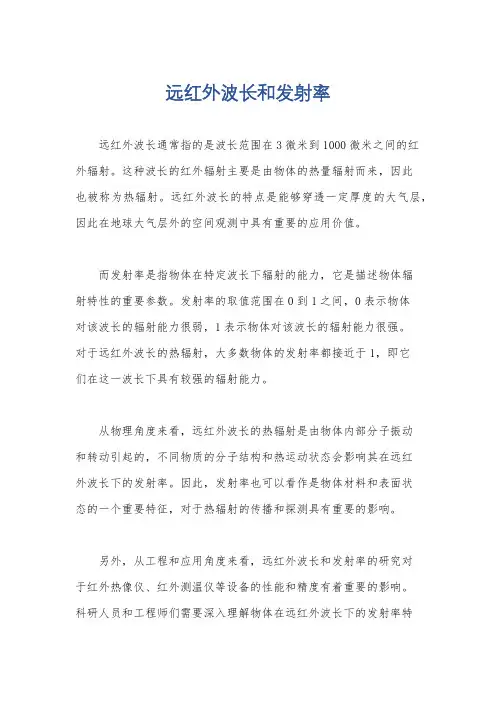
远红外波长和发射率
远红外波长通常指的是波长范围在3微米到1000微米之间的红
外辐射。
这种波长的红外辐射主要是由物体的热量辐射而来,因此
也被称为热辐射。
远红外波长的特点是能够穿透一定厚度的大气层,因此在地球大气层外的空间观测中具有重要的应用价值。
而发射率是指物体在特定波长下辐射的能力,它是描述物体辐
射特性的重要参数。
发射率的取值范围在0到1之间,0表示物体
对该波长的辐射能力很弱,1表示物体对该波长的辐射能力很强。
对于远红外波长的热辐射,大多数物体的发射率都接近于1,即它
们在这一波长下具有较强的辐射能力。
从物理角度来看,远红外波长的热辐射是由物体内部分子振动
和转动引起的,不同物质的分子结构和热运动状态会影响其在远红
外波长下的发射率。
因此,发射率也可以看作是物体材料和表面状
态的一个重要特征,对于热辐射的传播和探测具有重要的影响。
另外,从工程和应用角度来看,远红外波长和发射率的研究对
于红外热像仪、红外测温仪等设备的性能和精度有着重要的影响。
科研人员和工程师们需要深入理解物体在远红外波长下的发射率特
性,以便设计和制造出更加精准和可靠的红外探测设备。
综上所述,远红外波长和发射率是物体热辐射特性的重要参数,涉及到物理、材料科学以及工程技术等多个领域,对于科研和工程
应用具有重要的意义。
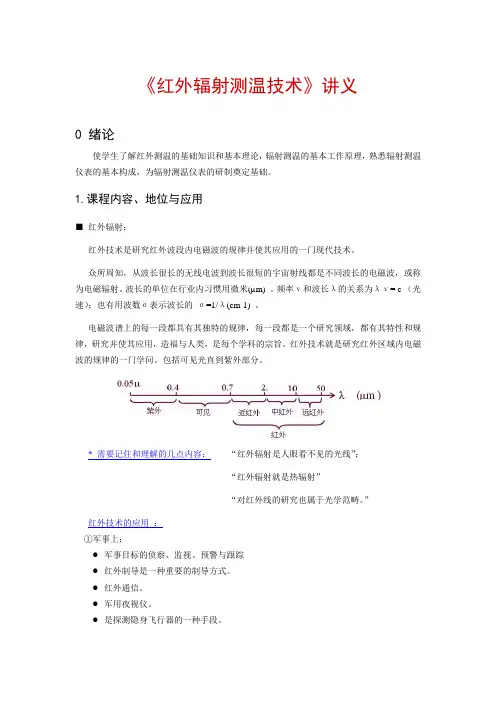
《红外辐射测温技术》讲义0 绪论使学生了解红外测温的基础知识和基本理论,辐射测温的基本工作原理,熟悉辐射测温仪表的基本构成,为辐射测温仪表的研制奠定基础。
1.课程内容、地位与应用■红外辐射:红外技术是研究红外波段内电磁波的规律并使其应用的一门现代技术。
众所周知,从波长很长的无线电波到波长很短的宇宙射线都是不同波长的电磁波,或称为电磁辐射。
波长的单位在行业内习惯用微米(µm) 。
频率ν和波长λ的关系为λν= c (光速);也有用波数σ表示波长的σ=1/λ(cm-1) 。
电磁波谱上的每一段都具有其独特的规律,每一段都是一个研究领域,都有其特性和规律,研究并使其应用,造福与人类,是每个学科的宗旨。
红外技术就是研究红外区域内电磁波的规律的一门学问。
包括可见光直到紫外部分。
* 需要记住和理解的几点内容:“红外辐射是人眼看不见的光线”;“红外辐射就是热辐射”“对红外线的研究也属于光学范畴。
”红外技术的应用:①军事上:●军事目标的侦察、监视、预警与跟踪●红外制导是一种重要的制导方式。
●红外通信。
●军用夜视仪。
●是探测隐身飞行器的一种手段。
● 对威胁进行红外告警。
②在民用方面:红外测温,红外遥控,红外遥感,红外医疗,红外加热,红外光谱技术。
总之,红外技术的应用及其广泛,它已涉及到军事战术或战略的情报搜集、目标的侦察监视、武器制导等各个领域,对未来战争产生重大的影响。
在工业、医学和科研等许多方面也广为使用,例如热源探测,医用热像仪、温度测量与过程控制、红外光谱分析、红外加热、红外遥感、红外天文学等。
■测温技术温度测量的方法可分两大类:辐射测温特点:优点:响应速度快、分辨率高,适用于旋转物体、移动物体、热容量小的物体、腐蚀性场合,以及接触式测温无法使用的条件下,辐射测温被广泛应用。
如:电力、冶金、化工橡胶等领域● 焊接、炉窑、焦化、电力(变压器) ● 感应加热、塑料、玻璃 ● 金属挤压成型 ● 热处理和退火缺陷:①一般辐射温度计都只能测得亮度温度或辐射温度,由于一般被测物体发射率都小于l ,所以不能测得真温度。
红外发射率和反射率关系红外发射率和反射率的关系,听起来有点复杂,其实简单得很。
想象一下,阳光下的水面,闪烁着光芒,给人一种美丽的感觉。
水的反射率非常高,阳光照射到上面,几乎没有多少会被水吸收。
这就是反射率的魅力,像一位优雅的舞者,把光线巧妙地反弹回去,让我们觉得这个世界充满了光辉。
可是,当你把手伸进水里,温度会明显下降。
这就是红外发射率的功劳,它让水能够把热量以红外线的形式发射出去,让你感受到冰冷的触感。
发射率和反射率就像一对好朋友,一个负责吸收,一个负责反射。
发射率高的材料,通常会把热量发射得很快,像个热情洋溢的人,完全不怕外界的冷风。
但是,反射率高的材料,像是一个小心翼翼的人,总是担心被吸收了什么,尽量把外来的光线挡在门外。
说到这里,咱们就得聊聊不同材料的发射率和反射率了。
比如,黑色的物体,它的发射率特别高,简直就是个热爱生活的家伙,喜欢把温暖分享给别人。
而白色的物体呢,反射率高得让人咋舌,像个酷酷的家伙,谁也不想靠近,光线照上去,呼啦一下就被反弹回去了。
你想,为什么太阳能热水器上会有那么多黑色的材料?这就是因为它们特别擅长吸收阳光,能把阳光转化为热量,热水的温度飙升,真是家里的“热心肠”。
反观那些涂有白色漆的房子,炎热的夏天,它们就像个避暑胜地,拒绝吸热,保持凉爽,实在是聪明的选择。
这也说明了一个道理,选择材料的时候,发射率和反射率要好好搭配,才能发挥出最大的效能。
再说说环境的影响吧,周围的温度、湿度都会对发射率和反射率产生影响。
比如在干燥的地方,材料的发射率可能会稍微提高,因为没有那么多水分的干扰。
而在潮湿的地方,材料的反射率则可能受到影响,光线被水分子散射得七零八落,让人眼花缭乱。
听起来复杂,其实这就像我们在不同的环境中待着,心情也会随之变化。
科技的发展让我们更深入地了解了这些关系。
实验室里的科学家们,像是探索未知世界的冒险者,不断地测量各种材料的发射率和反射率。
他们通过精密的仪器,能够准确地得出数据,真是让人佩服得五体投地。
反射率和透过率的关系
《反射率和透过率的关系》
嘿呀,咱今天来聊聊反射率和透过率这俩家伙的关系。
就说我有次去买眼镜吧,那店员可热情啦,给我介绍各种镜片。
我就好奇地问,这镜片的反射率和透过率是咋回事呀。
店员就很耐心地跟我说,反射率呢就是光照射到镜片上有多少被反射回去啦,透过率就是有多少光能穿过镜片。
我当时就想,这就好比我走在路上,遇到一堵墙,有的光就像皮球似的被墙给弹回来了,这就是反射;而有的光呢,就像个机灵的小猴子,能从墙的缝隙里钻过去,这就是透过。
我拿起不同的镜片看呀看,发现有些镜片反射的光很强,感觉都能当镜子照了,那这种镜片的反射率就高呗;而有些镜片呢,我透过它看东西特别清楚,几乎没啥阻碍,这透过率肯定就高啦。
然后我又想啊,这反射率和透过率是不是有点像跷跷板的两头呀,这边高了那边就低。
要是镜片反射率高了,那透过率不就相对低了嘛,那看到的东西可能就没那么清晰了;要是透过率高呢,反射率可能就低一些,看起来就更通透。
哎呀呀,就这么个简单的道理,我从买眼镜这件小事里可算是搞明白了。
以后再碰到反射率和透过率的问题,我就会想起那次买眼镜的经历,哈哈,这俩家伙的关系我算是清楚得很啦!
所以呀,生活中的小事情也能让我们明白大道理呢,反射率和透过率的关系就是这么有趣又实在!。
红外吸光度和透光率的换算公式红外吸光度和透光率,这两个看似高深莫测的术语,其实就像是我们生活中的两个好朋友。
它们虽然长得不一样,但都是测量光线透过物体能力的好帮手。
今天,我们就来聊聊这两个“小伙伴”之间的那些事儿。
让我们来认识一下“红外吸光度”。
这个小家伙可是个聪明的小侦探,它用一双“火眼金睛”去观察物体表面。
想象一下,如果你的皮肤上长了一颗痘痘,那么红外吸光度就像是一个神奇的放大镜,能够清晰地看到这颗痘痘的轮廓。
而当它发现某个区域特别亮堂时,那就意味着那个地方可能藏着一些不为人知的小秘密。
我们再来说说“透光率”,这可是个大人物哦!它就像是我们的眼睛,能够看透物体的外表,看到里面的真相。
想象一下,当你在森林里迷路时,是不是很希望有一双“透视眼”能帮你找到回家的路?而透光率就是这样一个神奇的存在,它能让你看清物体的真实面目。
红外吸光度和透光率之间又有什么关系呢?别急,让我来给你慢慢道来。
你知道吗,有些物体的表面可能会因为各种原因变得不那么光滑,就像我们的皮肤上有时候会长痘痘一样。
这时,红外吸光度就会像个小侦探一样,用它那双“火眼金睛”去观察这些“不速之客”。
而当我们需要知道这些“不速之客”到底藏在哪里时,就需要用到透光率这个“透视眼”了。
想象一下,当你在森林里迷路时,是不是很希望有一双“透视眼”能帮你找到回家的路?而透光率就是这样一个神奇的存在,它能让你看清物体的真实面目。
所以,红外吸光度和透光率就像是一对好朋友,它们相互配合,共同完成着对物体的“侦察”任务。
有了它们,我们就能更准确地了解物体的特性,从而更好地利用它们。
红外吸光度和透光率之间的关系并不是一成不变的。
它们还会闹点小矛盾。
比如,有时候我们会不小心让一个物体的表面变得不那么光滑,这时候红外吸光度可能会觉得有点“吃不消”,因为它需要更仔细地观察每一个细节。
而透光率则会安慰它说:“没关系,我会继续努力,帮你看清楚。
”所以,红外吸光度和透光率之间的关系就像是一场友谊的考验。
红外吸光度和透光率的关系(一)
红外吸光度和透光率的关系
1. 红外吸光度和透光率的概念
•红外吸光度:衡量物质对红外光的吸收程度或量的物理量。
•透光率:衡量物质对光线透过的能力,即光线通过物体后仍能透过的比例。
2. 两者的关系
•反相关关系:红外吸光度和透光率呈现一种反相关的关系,即吸光度高的物质透光率低,吸光度低的物质透光率高。
3. 解释说明
•吸光度高:当物质对红外光具有较高的吸收能力时,大部分红外光被物质吸收,只有极少量的红外光能通过物质,因此其透光率较低。
•透光率高:当物质对红外光的吸收能力较弱时,几乎所有的红外光能够透过物质,因此其透光率较高。
4. 应用领域
•检测红外光:利用物质的红外吸光度和透光率的关系,可以设计制造红外光检测装置,用于红外光的测量和分析。
•选材设计:在光学器件和红外传感器的设计中,需要根据具体需求选择具有适当红外吸光度和透光率的材料,以实现所需的光学
性能。
总结
红外吸光度和透光率是衡量物质对红外光吸收和透过能力的指标,它们呈现一种反相关的关系。
吸光度高的物质对红外光的吸收能力强,透光率较低;而透光率高的物质对红外光的吸收能力弱。
了解和掌握
红外吸光度和透光率的关系有助于光学领域的应用和材料选型。
红外波段的发射率、透过率和反射率的关系
Emissivity in the Infrared
Physics of Emissivity
Infrared (thermal) energy, when incident upon matter, be it solid, liquid or gas, will exhibit the properties of absorption, reflection, and transmission to varying degrees.
Absorption
Absorption is the degree to which infrared energy is absorbed by a material. Materials such as plastic, ceramic, and textiles are good absorbers. Thermal energy absorbed by real-world objects is generally retransferred to their surroundings by conduction, convection, or radiation.
Transmission
Transmission is the degree to which thermal energy passes through a material. There are few materials that transmit energy efficiently in the infrared region between 7 and 14µm. Germanium is one of the few good transmitters of infrared energy and thus it is used frequently as lens material in thermal imaging systems.
Reflection
Reflection is the degree to which infrared energy reflects off a material. Polished metals such as aluminum, gold and nickel are very good reflectors.
Conservation of energy implies that the amount of incident energy is equal to the sum of the absorbed, reflected, and transmitted energy.
Incident Energy = Absorbed Energy + Transmitted Energy + Reflected Energy
[1]
Emitted Energy = Absorbed Energy
Consider equation 1 for an object in a vacuum at a constant temperature. Because it is in a vacuum, there are no other sources of energy input to the object or output from the object. The absorbed energy by the object increases its thermal energy - the transmitted and reflected energy does not. In order for the temperature of the object to remain constant, the object must radiate the same amount of energy as it absorbs.
Emitted Energy = Absorbed Energy
[2]
Therefore, objects that are good absorbers are good emitters and objects that are poor absorbers are poor emitters. Applying equation 2, Equation 1 can be restated as follows:
Incident Energy = Emitted Energy + Transmitted Energy + Reflected Energy
[3]
Setting the incident energy equal to 100%, the equation 3 becomes:
100% = %Emitted Energy + %Transmitted Energy + %Reflected Energy
[4]
Because emissivity equals the efficiency with which a material radiates energy, equation 4 can be restated as follows:
100% = Emissivity + %Transmitted Energy + %Reflected Energy
[5]
Applying similar terms to %Transmitted Energy and %Reflected Energy,
100% = Emissivity + Transmissivity(透过率)+ Reflectivity
[6]
According to equation 6, there is a balance between emissivity, transmissivity, and reflectivity. Increasing the value of one of these parameters requires a decrease in the sum of the other two parameters. If the emissivity of an object increases, the sum of its transmissivity and reflectivity must decrease. Likewise, if the reflectivity of an object increases, the sum of its emissivity and trasmissivity must decrease.
Most solid objects exhibit very low transmission of infrared energy - the majority of incident energy is either absorbed or reflected. By setting transmissivity equal to zero, equation 6 can be restated as follows:
100% = Emissivity + Reflectivity
[7]
For objects that do not transmit energy, there is a simple balance between emissivity and reflectivity. If emissivity increases, reflectivity must decrease. If reflectivity increases, emissivity must decrease. For example, a plastic material with emissivity = 0.92 has reflectivity = 0.08. A polished aluminum surface with emissivity = 0.12 has reflectivity = 0.88.
The emissive and reflective behavior of most materials is similar in the visible and infrared regions of the electromagnetic spectrum. Polished metals, for example, have low emissivity and high reflectivity in both the visible and infrared. It is important to understand, however, that some materials that are good absorbers, transmitters, or reflectors in the visible, may exhibit completely different characteristics in the infrared.。